
More Type In Less Time through Automatic Typecasting
(Plainview, NY: Fairchild Graphic Equipment, 1961). A good general overview of the system; it was much more than just tape-control of linecasters.
The icon at left links to a presentation of this work at The Internet Archive. Here is a local copy of the PDF (241 Megabytes): fairchild-tts-more-type-in-less-time-c1-0600rgb.pdf

Fairchild TTS Light Touch Standard Perforator
(Plainview, NY: Fairchild Graphic Equipment, [no date]).
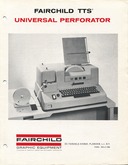
Fairchild TTS Universal Perforator
(Plainview, NY: Fairchild Graphic Equipment, [no date]).
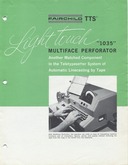
Fairchild TTS Light Touch "1035" Multiface Perforator
(Plainview, NY: Fairchild Graphic Equipment, [no date]).
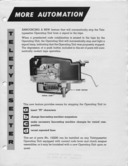
More Automation [Part Set No. 132228]
More Automation. (Chicago: Teletypesetter Corporation, [n.d.]) This is an advertisement for set of parts No. 132228, which when installed will allow the linecaster to be stopped under tape control.
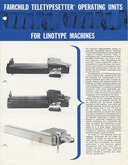
Fairchild Teletypesetter Operating Units for Linotype Machines
(Plainview, NY: Fairchild Graphic Equipment, [no date]). Standard Operating Unit TOU-15 (for machines running at up to 10 lines per minute). Universal Operating Units TOU-11 (Comet) and TOU-17 (other Linotypes running at up to 12 lines per minute). Operating Units TOU-75-2 (Comet), TOU-75-3 (Elektron) and TOU-75-4 (Linotype Quick); operating units (but not the Linotypes) capable of 28 lines per minute.
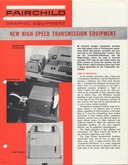
New High-Speed Transmission Equipment
(Plainview, NY: Fairchild Graphic Equipment, [no date]). Transmitter-Distributor. Reperforator. Page Printer.
In understanding the Selective Allocator, recall first that it isn't necessary with TTS equipment to physically remove a tape from a Perforator and carry it to a linecaster. A Transmitter-Distributor can take the output of a Perforator and transmit it electrically to a Reperforator located at the linecaster. The Reperforator creates a new tape which is fed automatically into the linecaster. It is therefore possible to use the Perforator / Transmitter-Distributor / Reperforator combination effectively to control a linecaster from a remote keyboard.
This can be inefficient for two reasons, however. First, a TTS-operated linecaster can produce work faster than a single Perforator operator can supply it. Second, a single Perforator operator may be given copy of several different types, each of which requires a different linecaster configuration (of magazines, fonts, molds, etc.) Handling these different styles of copy on a single linecaster controlled remotely by a single Perforator is inefficient because it would require a reconfiguration of the linecaster (magazines changes and possibly mold changes) for each change in copy style. Handling them on multiple linecasters each set up for a particular style of copy would be more efficient, but would have to be accomplished by manually carrying tapes to the linecasters.
The Selective Allocator solves this problem by allowing a single Perforator operator to choose up to three different kinds of copy, each of which is routed automatically to a reperforator on a linecaster set up to handle this kind of copy.
It generalizes this by allowing up to six Perforators and up to two wire service lines (each of which may be submitting copy in up of up to three different kinds). Moreover, it can control up to 10 linecasters. As input copy becomes available, the Selective Allotter automatically routes it to the next available linecaster which has been set up to handle that kind of copy.
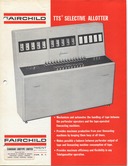
Fairchild TTS Selective Allotter
(Plainview, NY: Fairchild Graphic Equipment, 1961).
See also the Shaffstall Mat Detector, in its original vacuum tube and later transistorized forms.
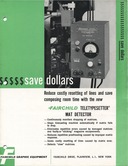
[...] Fairchild Teletypesetter Mat Detector
$$$$$ save dollaars[:] Reduce costly resetting of lines and save composing room time with the new Fairchild Teletypesetter Mat Detector . (Plainview, NY: Fairchild Graphic Equipment, 1961).

Fairchild Rule Dropper
New! Fairchild TTS Rule Dropper for Classified Ad Composition (Plainview, NY: Fairchild Graphic Equipment, 1961).


The two images above (click on them for more legible versions) are the front and back of a plastic pocket scale. It shows the Teletypesetter tape punch code.
The Fairchild Graphic Equipment literature reprinted here was either published in the US without copyright notice at a time when such notice was required to secure copyright (and so passed into the public domain upon initial publication) or was copyrighted at publication but the copyright was not renewed as was then required. The digital versions of them reprinted here remain in the public domain.
(The "Fairchild Rule Dropper" brochure doesn't specify its author/publisher, and was associated in the material in which I received it with a cover letter from the Canadian Linotype Company. However, based on internal evidence in the document it must have been published by Fairchild, not Canadian Linotype (and thus subject to US copyright law). It refers to "linecasting machines," whereas if it had been by Canadian Linotype it would have referred to Linotypes.)
All portions of this document not noted otherwise are Copyright © 2009-2010, 2012 by David M. MacMillan and Rollande Krandall.
Circuitous Root is a Registered Trademark of David M. MacMillan and Rollande Krandall.
This work is licensed under the Creative Commons "Attribution - ShareAlike" license. See http://creativecommons.org/licenses/by-sa/3.0/ for its terms.
Presented originally by Circuitous Root®
Select Resolution: 0 [other resolutions temporarily disabled due to lack of disk space]